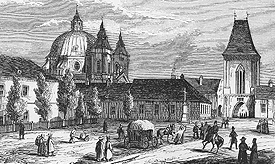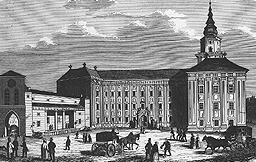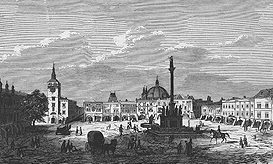History of Kromeriz
 The word "Kromeriz" is undoubtedly of Slavic origin. It refers to someone respectable within own tribe and famous even outside the territory in question. In the Great Moravian Era (9th century AD), the area accommodated a Slavic fortified settlement that
guarded the important intersection of trading paths at a ford across the river of Morava. The old Salt Path - leading from the Austrian Salt Chamber to the north of Moravia - and the Amber Path - stretched from the Baltic to the Adriatic Sea - interlaced
one another in these places. This junction held its importance through the Romanesque age as a Slavic market town with homestead. Finally, Bishop Bruno of Schaumburk (1245-81) built the forts and walls andendowed the market town with the freedoms and privileges
of a city. The Romanesque homestead was rebuilt to a Gothic castle that became the centre of the fief dominion and the seat of the Liege Law Court. Bishop Stanislav Thurzo (1497-1560) originated the modifications of castle in a Renaissance style. In 1509,
the Bishop invited king Vladislav II referring to the gorgeous garden that would befit the needs of Prince Ludvík (Louis). The chateau gallery boasts four pictures by L. Cranach senior, two of which are furnished with the bishop's sign indicating direct
procurement. In 1588, Emperor Rudolph II re-granted the bishops with the title of prince, in 1608 he re-established the right of coinage for the Moravian Diocese. Kromeriz was conquered by the Swedish Marshal Torstenson in 1643 - only two years short of
the end of the Thirty Years' War. The city along with the chateau were totally burned down, then ruined on another two occasions to finally suffer and die out from the pestilence in 1645. Out of 244 farmstead, only 69 remained inhabited though partly ruined.
It took years and years for the city to recover from such a severe deadly blow.
The word "Kromeriz" is undoubtedly of Slavic origin. It refers to someone respectable within own tribe and famous even outside the territory in question. In the Great Moravian Era (9th century AD), the area accommodated a Slavic fortified settlement that
guarded the important intersection of trading paths at a ford across the river of Morava. The old Salt Path - leading from the Austrian Salt Chamber to the north of Moravia - and the Amber Path - stretched from the Baltic to the Adriatic Sea - interlaced
one another in these places. This junction held its importance through the Romanesque age as a Slavic market town with homestead. Finally, Bishop Bruno of Schaumburk (1245-81) built the forts and walls andendowed the market town with the freedoms and privileges
of a city. The Romanesque homestead was rebuilt to a Gothic castle that became the centre of the fief dominion and the seat of the Liege Law Court. Bishop Stanislav Thurzo (1497-1560) originated the modifications of castle in a Renaissance style. In 1509,
the Bishop invited king Vladislav II referring to the gorgeous garden that would befit the needs of Prince Ludvík (Louis). The chateau gallery boasts four pictures by L. Cranach senior, two of which are furnished with the bishop's sign indicating direct
procurement. In 1588, Emperor Rudolph II re-granted the bishops with the title of prince, in 1608 he re-established the right of coinage for the Moravian Diocese. Kromeriz was conquered by the Swedish Marshal Torstenson in 1643 - only two years short of
the end of the Thirty Years' War. The city along with the chateau were totally burned down, then ruined on another two occasions to finally suffer and die out from the pestilence in 1645. Out of 244 farmstead, only 69 remained inhabited though partly ruined.
It took years and years for the city to recover from such a severe deadly blow.
 At last, history took a reverse course when Charles II of Liechtenstein-Castlecorn (1664-1695) was elected as new bishop.
The rumours were going around the day he acceded to the office, that time he stepped out to the terrace on the castle tower, looked down
to the devastated city and burst into tears. Nevertheless he soon resolved to give his residential city a real princely appearance. Thus, a new Building Control Department was established in Kromeriz. The office were to administrate and control numerous Bishop's
projects in the field of constructions, as well as to encourage the burghers to reconstruct the houses and other facilities. The devastated castle itself was not able to provide even a temporary housing, the Bishop resided in one of the Chapter houses. But
in the very year following his enthronement, he commenced large-scale works to create an Italian-type garden located beyond the walls of the city. The garden was named "Libosad", nowadays it is called Kvetna Zahrada (Flower Garden). The Bishop Liechtenstein
also remodelled the Chateau Garden (Podzamecka zahrada), reworked the town walls, reconstructed the water conduit, built new fountains, a Mint-House, established the steady surgery. In addition, he introduced into the town the Piarists and provided
them with brand new college, lyceé, and a seminar of singing. In 1689, the Wall of Piece was built dividing the town from the Jewish ghetto, where he founded a Jewish Guildhall.
At last, history took a reverse course when Charles II of Liechtenstein-Castlecorn (1664-1695) was elected as new bishop.
The rumours were going around the day he acceded to the office, that time he stepped out to the terrace on the castle tower, looked down
to the devastated city and burst into tears. Nevertheless he soon resolved to give his residential city a real princely appearance. Thus, a new Building Control Department was established in Kromeriz. The office were to administrate and control numerous Bishop's
projects in the field of constructions, as well as to encourage the burghers to reconstruct the houses and other facilities. The devastated castle itself was not able to provide even a temporary housing, the Bishop resided in one of the Chapter houses. But
in the very year following his enthronement, he commenced large-scale works to create an Italian-type garden located beyond the walls of the city. The garden was named "Libosad", nowadays it is called Kvetna Zahrada (Flower Garden). The Bishop Liechtenstein
also remodelled the Chateau Garden (Podzamecka zahrada), reworked the town walls, reconstructed the water conduit, built new fountains, a Mint-House, established the steady surgery. In addition, he introduced into the town the Piarists and provided
them with brand new college, lyceé, and a seminar of singing. In 1689, the Wall of Piece was built dividing the town from the Jewish ghetto, where he founded a Jewish Guildhall.
The castle library was granted an amount covering the expenses related to the purchase of new books and to the post of steady librarian. The new castle band, with its 36 members, ranked among the largest European ensembles of its kind. In 1673, the Bishop
purchased the collection of pictures owned by Franz and Bernard Imstenreadori brothers. Their uncle Ewerhard Jabach, and his collection, was in fact the founder of the Louvre gallery. Thus, the castle gallery was bejewelled with the world-wide
famous masterpieces.
In 1673, the Bishop
purchased the collection of pictures owned by Franz and Bernard Imstenreadori brothers. Their uncle Ewerhard Jabach, and his collection, was in fact the founder of the Louvre gallery. Thus, the castle gallery was bejewelled with the world-wide
famous masterpieces.
In the revolutionary year of 1848, the Great Dinning Hall housed the Empire-wide Assembly of Nations. Although the sessions of this "parliament" were dissolved on the late March 1849, the term "Assembly Hall" has been absorbed in the language. The room itself has attained the importance of a national memorabilia.
INTERESTED IN MORE DETAILED HISTORY OF KROMERIZ - Click Here...
One Liner Joke